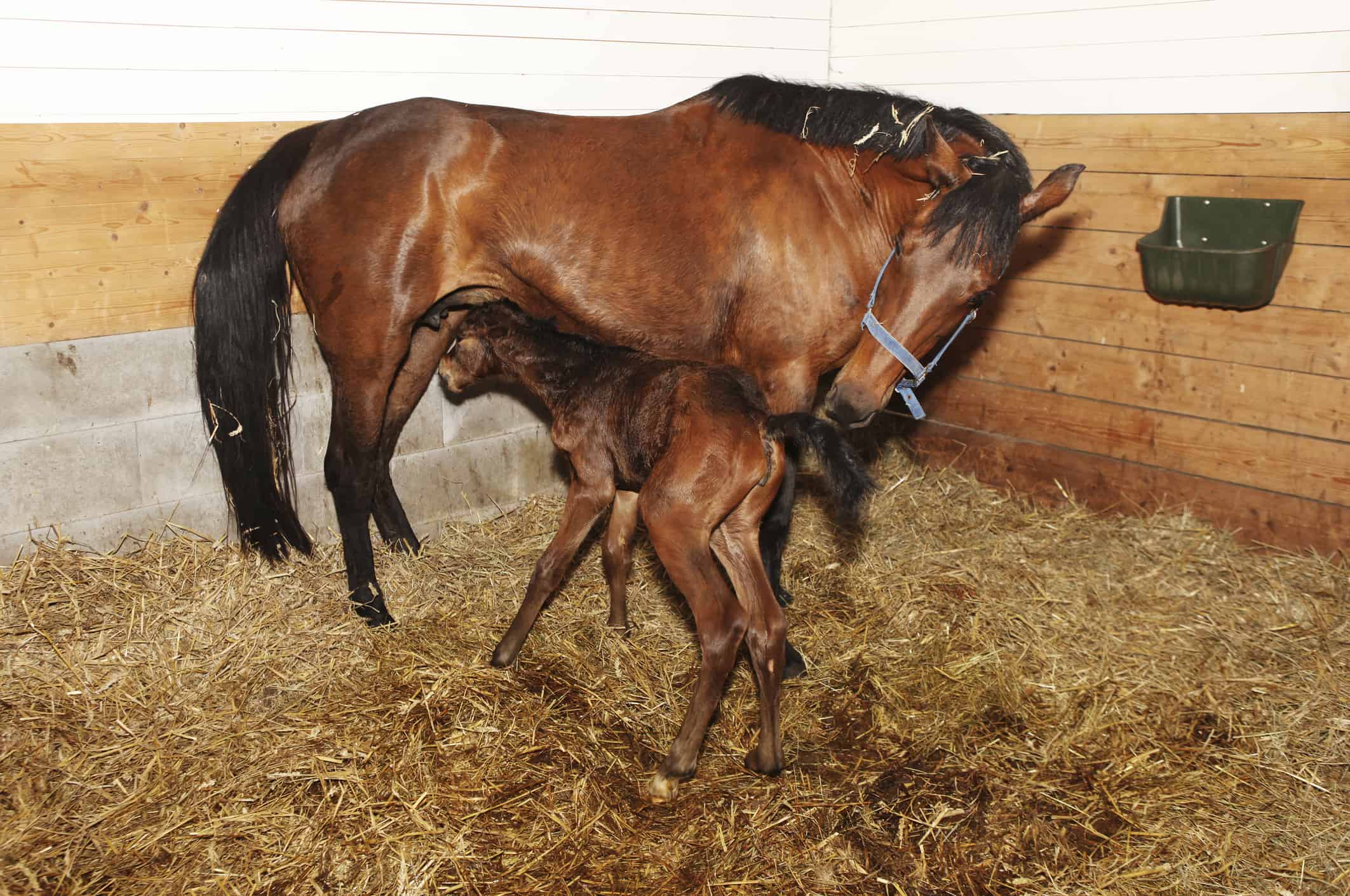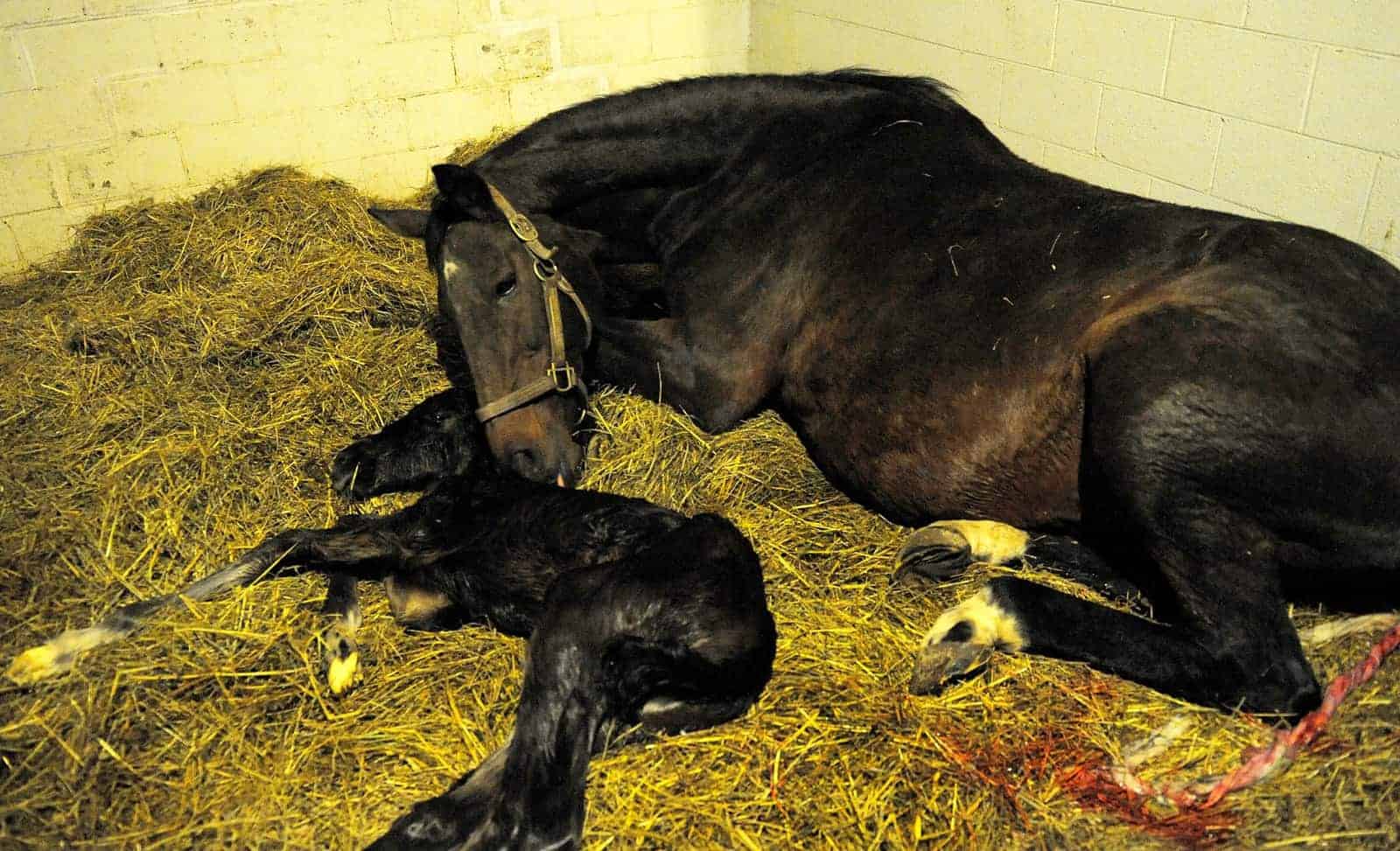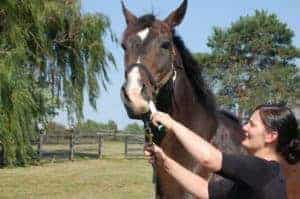During and After Foaling: What To Expect

Things happen quickly during foaling, and time is of the essence in the minutes, hours, and days following to ensure a healthy foal. To help guide breeders through the process, two assistant professors and AgriLife Extension horse specialists from Texas A&M University—Chelsie Huseman, PhD, and Jennifer Zoller, PhD—described what to expect and steps to take during a webinar hosted by the American Youth Horse Council.
The Three Stages of Labor
A healthy birth should follow three stages that occur within specific time frames. Any stage that lasts longer than normal should prompt an immediate call to your veterinarian. They include:
- Contractions start. As the mare goes into labor, she might be nervous, restless, and sweaty. This period typically lasts one to four hours and ends when the water breaks and the mare expels 2 to 3 gallons of fluid.
- The foal is delivered. This stage begins when the water breaks and ends when the foal is born and should last anywhere from 5 to 20 minutes. During this process, you might see a white sac begin to protrude from the mare’s vulva. This is the amnion, or placental membrane encasing the foal, Zoller explained. If the birth is normal, you’ll see the foal’s front feet emerge (one slightly in front of the other so the shoulders can pass through the birth canal diagonally and more easily), followed by the nose, knee joints, head, and body. It’s normal for the mare to strain and push through this process, she said.
- Expulsion of the placenta. Once the foal stands and begins nursing, a flood of oxytocin hormones will cause the mare to release and pass the placenta. She should pass the placenta in one to three hours. Resist the temptation to pull it out at all costs, said Zoller, because if any parts of the placenta detach and remain inside the mare, she can develop a serious infection. Tie the placenta up to keep her from stepping on it, if necessary, while it passes.

If you enter the stall to clear the foal’s nostrils or tie up the placenta, keep an eye on the mare, because she can become aggressive post-foaling. Also resist the urge to clean the foal off, which the mare should do herself as part of the bonding process.
“Don’t intervene unless there’s a problem,” said Zoller. “Be a quiet observer.”
The Immediate Post-Foaling Period
When assessing a newborn foal, said Huseman, consider the 1-2-3 rule. A healthy foal should:
- Stand in one hour.
- Nurse in two hours.
- Pass meconium in three hours.
The passing of meconium is an important step, she said. This is the foal’s first manure, which is usually dark greenish-brown or black and hard and pasty in consistency. If the foal doesn’t pass it within three hours, he might start to show coliclike signs of discomfort. If administering one or two enemas doesn’t result in passing meconium, said Huseman, call your veterinarian.
What to Put in Your Foaling Kit
Prepare for foaling and make caring for mare and foal easier with a well-stocked foaling kit. Jennifer Zoller, PhD, shared common items Texas A&M staff store in their kits:
- A stethoscope to monitor mare heart rate (usually 28-44 beats per minute, but know your mare’s normal range) leading up to foaling and foal heart rate just after birth (80-100 bpm for newborns).
- A digital thermometer to rule out infection or inflammation. A normal temperature for an adult horse is 99-101 degrees F and for foals is 99-102 degrees F. “Have record of what your mare’s normal temperature is so you can know what’s a problem, and list those figures in your kit so other people know,” said Zoller.
- Rubber gloves to wear during foaling, when handling the placenta, and when disinfecting the foal’s umbilicus.
- A trash bag to hold the placenta once the mare has passed it, so you and your veterinarian and weigh and inspect it later.
- A towel to dry, warm, and clean the foal if the mare can’t attend to this duty herself.
- An enema to help the foal pass the meconium (first manure) if necessary.
- Small disposable cups for dipping the foal’s naval in disinfecting 1% chlorhexidine solution a couple of times a day for the first few days.
- A measuring tape to monitor foal growth.
- A flashlight or headlamp, especially if the mare foals in a pasture.
- Vetrap to wrap the mare’s tail to keep it clean and out of the way.
- Scissors for cutting Vetrap, tape, etc.
- Mild hand soap to clean the mare’s teats before foaling.
- A stopwatch to monitor the stages of foaling.
- A notebook for keeping records.
- Your veterinarian’s contact info in case of an emergency.
You can store all these items in an easy-to-transport bucket with a handle or a bin with a lid to keep everything secure.
—Alexandra Beckstett
Another vital milestone in the first 24 hours of life is colostrum intake. This is the mare’s antibody-rich first milk that foals must ingest soon after birth (ideally, within six to eight hours) and in high levels to gain protection against infectious diseases.
“Make sure the foal is nursing well in the first 12 hours,” said Huseman. “Ideally, foals should ingest 1 to 2 liters of colostrum within that time frame. Mares produce less and less colostrum between 12 and 24 hours, at which point those antibody levels become really low.”
Sometimes, complications such as a weak foal or a mare that resists his nursing attempts inhibit colostrum ingestion. “The good news,” said Huseman, “is we can harvest colostrum by milking the mare. Capture and preserve any dripping milk prior to parturition (birth), because her supply is limited.”
Once you’ve collected colostrum from the mare, you can feed it to the foal using a bottle or bucket with a nipple. “Worst case, your veterinarian can tube colostrum directly into the foal’s stomach,” she added.
You might also encounter issues if the mare has poor-quality colostrum, even if the foal is nursing well. For this reason, said Huseman, always test the mare’s colostrum (which you can easily do using an on-farm refractometer test) to determine whether it’s of adequate quality to provide immunity. Also have her colostrum tested and compared with the foal’s blood type for neonatal isoerythrolysis, a serious condition in which a mare’s antibodies attack her foal’s red blood cells.
If you’re concerned about failure of passive transfer (when the foal doesn’t receive enough antibodies from colostrum), your veterinarian can test the foal for adequate immunity using an on-farm SNAP test. He or she will place a blood sample in the testing device, which reveals the level of plasma antibodies in the blood. If it’s low, said Huseman, you have options to help the foal get the immunity he needs, including colostrum from a colostrum bank or, if 24 hours have passed, intravenous infusion of immunoglobulin G antibodies directly into his circulatory system.
Take-Home Message
Consult with your veterinarian well before your mare foals to establish a game plan for a successful foaling and contingencies if something goes wrong. By understanding the three stages of labor and the 1-2-3 rule for newborns, you’ll be better equipped to react quickly if issues arise.

Written by:
Alexandra Beckstett
Related Articles
Stay on top of the most recent Horse Health news with












